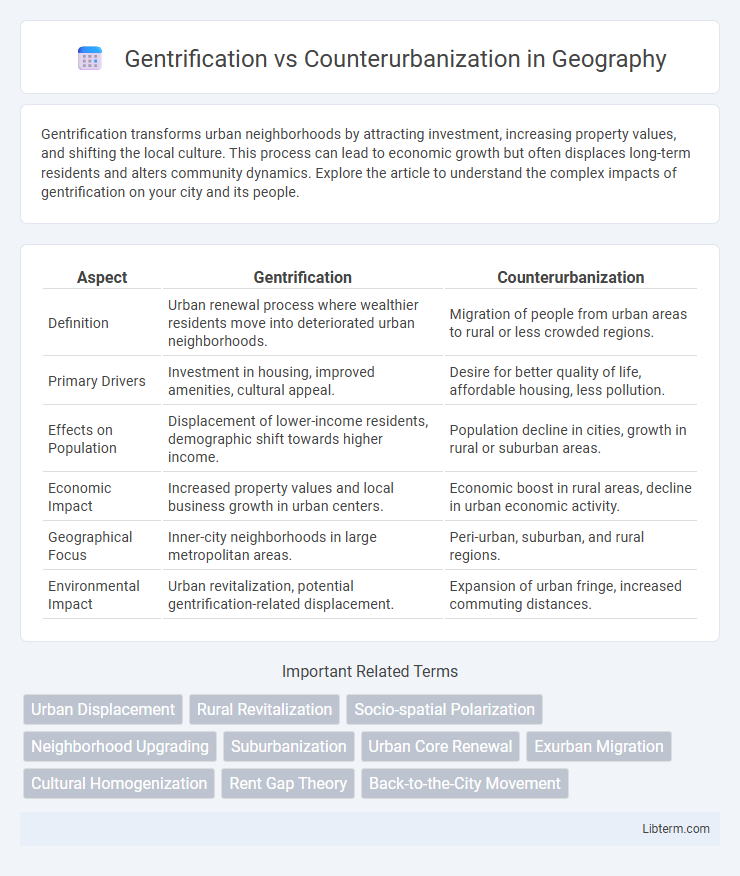Gentrification transforms urban neighborhoods by attracting investment, increasing property values, and shifting the local culture. This process can lead to economic growth but often displaces long-term residents and alters community dynamics. Explore the article to understand the complex impacts of gentrification on your city and its people.
Table of Comparison
| Aspect | Gentrification | Counterurbanization |
|---|---|---|
| Definition | Urban renewal process where wealthier residents move into deteriorated urban neighborhoods. | Migration of people from urban areas to rural or less crowded regions. |
| Primary Drivers | Investment in housing, improved amenities, cultural appeal. | Desire for better quality of life, affordable housing, less pollution. |
| Effects on Population | Displacement of lower-income residents, demographic shift towards higher income. | Population decline in cities, growth in rural or suburban areas. |
| Economic Impact | Increased property values and local business growth in urban centers. | Economic boost in rural areas, decline in urban economic activity. |
| Geographical Focus | Inner-city neighborhoods in large metropolitan areas. | Peri-urban, suburban, and rural regions. |
| Environmental Impact | Urban revitalization, potential gentrification-related displacement. | Expansion of urban fringe, increased commuting distances. |
Introduction to Gentrification and Counterurbanization
Gentrification involves the transformation of urban neighborhoods through an influx of middle- or upper-class residents, leading to increased property values and displacement of lower-income communities. Counterurbanization describes the movement of people from urban centers to rural or suburban areas seeking better quality of life, lower living costs, and reduced congestion. Both phenomena impact urban demographics, housing markets, and social structures but occur in contrasting geographic and socioeconomic contexts.
Defining Gentrification: Causes and Characteristics
Gentrification involves the transformation of urban neighborhoods through an influx of higher-income residents, driven by factors such as rising housing demand, urban policy incentives, and the attraction of city amenities. This process leads to increased property values, displacement of lower-income communities, and changes in social dynamics. Key characteristics include renovation of deteriorated housing, shifts in demographic profiles, and commercial redevelopment focused on affluent consumers.
Understanding Counterurbanization: Trends and Drivers
Counterurbanization involves the migration of people from urban to rural areas, driven by factors such as high urban living costs, desire for improved quality of life, and advancements in remote work technology. This demographic shift leads to the revitalization of rural communities and changing socio-economic dynamics, contrasting with gentrification, which primarily affects inner-city neighborhoods. Key trends include population decentralization, increased demand for rural housing, and infrastructure development to support new residents.
Historical Context: Urban Change Over Time
Gentrification emerged in the mid-20th century as urban neighborhoods experienced reinvestment, leading to displacement of lower-income residents and a shift in socioeconomic demographics. Counterurbanization gained momentum in the late 20th century, characterized by migration from cities to rural or suburban areas driven by desires for better living conditions and technological advances. Both processes reflect shifting economic, social, and cultural dynamics influencing urban change over time.
Economic Impacts: Winners and Losers
Gentrification drives economic growth by increasing property values and attracting investment, benefiting property owners and local businesses but often displacing low-income residents unable to afford rising costs. Counterurbanization redistributes economic activity from urban centers to rural or suburban areas, stimulating local economies but potentially causing reduced revenue and service decline in cities losing population. Both processes create distinct economic winners--often wealthier groups--and losers, mainly marginalized communities facing displacement or declining urban services.
Social Consequences: Communities in Transition
Gentrification often leads to the displacement of long-term, lower-income residents as rising property values and living costs alter neighborhood demographics, intensifying socio-economic inequalities. Counterurbanization prompts demographic shifts as urban dwellers move to rural or suburban areas, potentially revitalizing local economies but also straining existing infrastructure and disrupting established social networks. Both processes transform community identities and social cohesion, with gentrification frequently causing cultural homogenization and counterurbanization introducing diverse, sometimes conflicting, social dynamics.
Housing Market Dynamics: Affordability and Access
Gentrification drives up housing prices in urban neighborhoods, reducing affordability and displacing long-term residents as demand for revitalized areas increases. Counterurbanization causes a redistribution of population to rural and suburban regions, easing urban housing pressure but often leading to rising costs and limited access in these smaller markets. Both processes reshape housing market dynamics by altering supply-demand balances and influencing affordability and access across different geographic contexts.
Cultural Shifts: Identity, Diversity, and Displacement
Gentrification triggers cultural shifts by altering neighborhood identity, often displacing long-standing residents and reducing ethnic diversity through rising property values and changing social norms. Counterurbanization fosters cultural diversification as migrants from urban areas bring new cultural practices to rural or suburban locales, transforming local identities without necessarily causing immediate displacement. Both processes reshape community dynamics, impacting social cohesion and the preservation of cultural heritage in distinct ways.
Policy Responses: Managing Urban Transformation
Policy responses to gentrification often prioritize affordable housing mandates, rent control measures, and community land trusts to mitigate displacement and preserve neighborhood diversity. Counterurbanization management involves infrastructure investments, zoning reforms, and incentives to support sustainable development in suburban and rural areas while preventing sprawl. Coordinated urban planning frameworks emphasize inclusive growth, integrating social equity goals with economic revitalization to balance transformative urban dynamics.
Future Outlook: Balancing Growth and Equity
Gentrification often drives urban revitalization but risks displacing long-term residents, necessitating inclusive housing policies and community engagement to ensure equitable growth. Counterurbanization, characterized by migration to smaller towns or rural areas, offers opportunities to alleviate urban density while promoting sustainable regional development. Future urban planning must integrate smart growth strategies and equitable resource distribution to balance economic expansion with social justice effectively.
Gentrification Infographic

 libterm.com
libterm.com